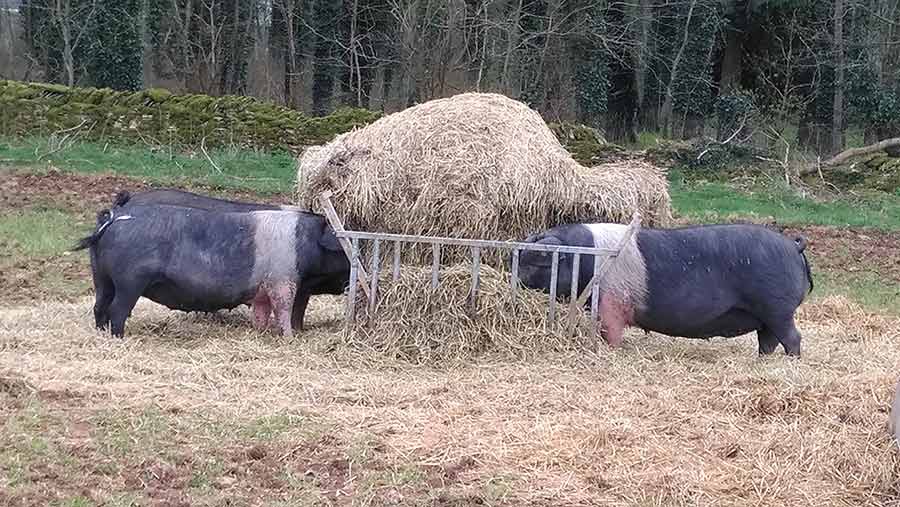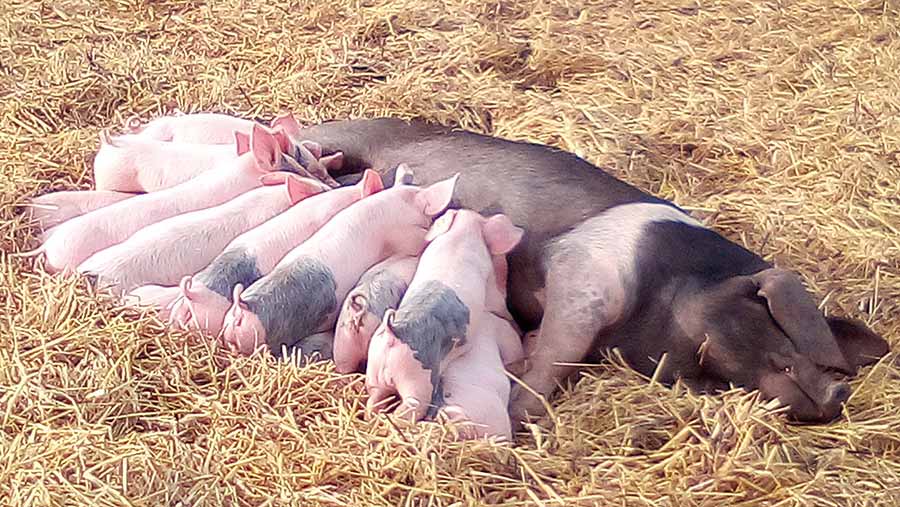How do field beans and forage stack up in pig diets?
 © Tim Scrivener
© Tim Scrivener With global supplies looking vulnerable and farmers facing huge spikes in feed prices, there is no better time to look at viable alternatives to feeding imported soya.
The good news is that preliminary results from a recent three-year European project have found good alternatives for pig and poultry diets, all of which can be grown within the UK.
The UK imports 3.2m tonnes of soya beans each year and, of this, an estimated 40% comes from sources that risk deforestation, according to the UK Roundtable on Sustainable Soya.
As well as saving forests, breaking the UK’s reliance on imported soya is increasingly important, as current supply chain disruptions from China and India have seen soya prices rocket more than 80% in the 12 months to June.
See also: 4-step guide to pig feeding and rations
About the trial
Farmers have been working in a field lab, which was run through Innovative Farmers, a programme that supports practical on-farm trials.
Among the alternative sources of proteins investigated was heat-treated beans for pigs.
The field lab was part of an EU Horizon 2020-funded research project, OK-Net Eco Feed, with different feeds trialled in each participating country.
The UK part of the project was co-ordinated by the Organic Research Centre, in collaboration with the Soil Association.
Beans
Field beans are commonly grown as a break crop in the UK, but they are unpopular as animal feed owing to their anti-nutritional factors.
Tannins in the hull bind with protein and starch to make feed less palatable, and trypsin inhibitors reduce the activity of the trypsin enzyme involved in protein digestion, reducing growth rates.
To overcome these issues, beans were dehulled or heat-treated to 180C for 15 minutes and sent to a laboratory for analysis, where they were compared with untreated beans.
Bean protein content |
||||
|
Sample treatment |
Protein (%) as fed |
Change in protein (%) compared with control |
Protein (%) adjusted for dry matter content |
Change in protein (%) compared with control |
|
Control |
25.5 |
30.3 |
||
|
Toasted |
26.3 |
+3 |
30.9 |
+2 |
|
Dehulled |
27.2 |
+6.66 |
32.3 |
+6.66 |
Change in trypsin inhibitor activity (TIA) |
||||
|
Sample treatment |
TIA (mg/g) as fed |
Change in TIA (%) compared with control |
TIA (mg/g) adjusted for dry matter content |
Change in TIA (%) compared with control |
|
Control |
0.8 |
|
0.93 |
|
|
Toasted |
0.5 |
-37.5 |
0.59 |
-36.7 |
|
Dehulled |
1.7 |
+112.5 |
2.02 |
+117.5 |
Heating helped reduce the volatile oils and sugars in the beans, improving protein content, while dehulling lowered tannin levels.
Researchers say both processes could produce a feedstuff suitable for replacing, or partially replacing, soya bean meal.
Heat-treating did not reduce amino acid levels, and this is particularly important for the sulphur-containing amino acids methionine and cysteine, which are the most limiting in pig rations.
The dehulling process removes the outer hull, which is the part of the bean low in protein (6% crude protein) and high in fibre.
This results in an increased protein content in the bean meal. The hulls can be used as bedding, composted or fed to ruminants.
Jerry Alford, Innovative Farmers field lab co-ordinator and arable and soils adviser at the Soil Association, says:
“For organic farmers, in particular, the trial results offer a way to achieve 100% organic feed without the carbon footprint associated with imported products, something many producers have always felt goes against organic principles.”
The next stage would be for beans to be fed on pig farms and see how they perform, although this will be dependent on future funding, says Mr Alford.
Case study: Eastleach Downs Organic Farm, Cirencester

© Wade Pigs
Organic pig producers Sam and Helen Wade are saving £70-£90/t on purchased feed and reducing the need for soya by growing and feeding home-grown protein.
The Wades, who run a 50-sow farrow-to-finish herd in Gloucestershire and sell pork direct, have been growing red clover and grass leys to improve soil fertility.
Although forage was not part of the Innovative Farmers field lab, Mr Wade has been part of farmer meetings, held as part of the project to guide the direction of the research.
Farm facts
Eastleach Downs Organic Farm, Cirencester, Gloucestershire
- Outdoor 50 sow farrow-to-finish herd
- Total 127ha (315 acres)
- Organic, Higher-Level Stewardship
- Tenant farmers on the Hatherop Estate
- On-farm butchery
- Sells pork through a box scheme and supplies Helen Browning’s Organics
Sows at Eastleach Downs Organic Farm browse this green cover during the summer months, and in the winter they are fed silage ad-lib alongside a 16% bought-in crude protein ration.
Feeding silage has already helped cut concentrate by 2kg a sow a day.
Mr Wade says: “This is not only economically efficient in reducing concentrate feed, but also provides the pigs with gut-fill, resulting in more contentment among the animals.”
“The challenge with feeding silage is that you have to keep an eye on condition. Even fed at low levels, pigs can eat large amounts and you don’t want them getting fat, especially the closer they get to farrowing,” advises Mr Wade.
As part of his quest to produce pork free of soya, he has been converting breeding stock to a British Saddleback crossed with a Large White to create a hardier pig that is better able to use this forage-based diet.
“We want a pig that has greater longevity and doesn’t grow as big,” he explains.
He is now two-thirds of the way through the changeover and says finished pigs are holding fat better than their previous breed of a commercial Duroc cross Landrace and Large White.

© Wade Pigs
Grower ration changes
Not content with stopping there, this year Mr Wade has trialled feeding growing pigs square baled silage alongside a home-grown ration comprising just 5% soya, along with peas, barley and beans grown on the farm.
Piglets were weaned at eight weeks and this ration was fed from 12 weeks of age, he explains. The first batch of 26 pigs killed out at 82kg deadweight at 65% lean content.
Carcass fat had increased 3-4ml to 16ml although this is well within their contract specification of 18-20ml of fat.
Challenges and the future
Mr Wade says consumers aren’t currently asking about soya, but he thinks this will change, and wants to be able to capitalise on it when it does.
“I would love the day to come when it becomes our selling advantage. If we were organic and soya-free I don’t think you could get much better.”
Eventually, he would like to be able to feed 100% home-grown protein to all pigs and negate the need to buy in any soya.
The biggest challenge has been feeding meal in hoppers, but they have conquered this by rolling the ration, instead of grinding it, which has improved the flow. Although dung has been passing through the sows quicker, it has not affected appetite.
Mr Wade believes feeding home-grown protein isn’t restricted to smaller units such as his own.
“There’s no reason it couldn’t be multiplied on a larger unit, and there is interest from commercial farmers, who have already started asking their compounder to produce a soya-free ration,” he says.
